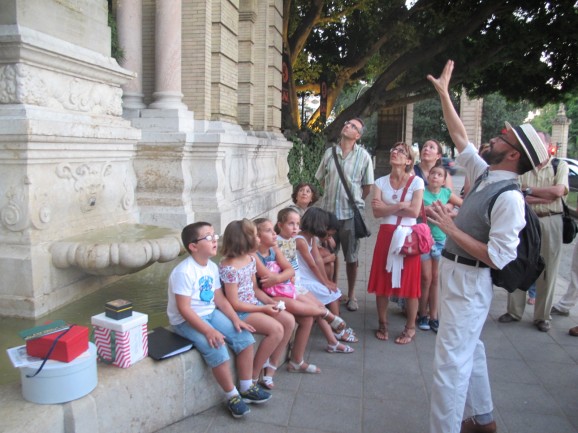
Night Tours in Seville – Reliving the 1929 Expo
This year, many tour companies in Seville are expanding their offerings, with more options for night-time tours available. This is in addition to the extensive programme of cultural events mentioned in a recent post, nearly all of which are outdoors. After dark is the best time to enjoy the city's most historic spots, after the day's extreme heat has dissipated.

Parque Maria Luisa is hosting dramatized tours. The one I tried, on Thursdays, was "A Night at the Ibero-American Expo 1929", by Espiral Patrimonio. We were given a map marking all the original pavilions: Seville's Expo 29 was decades in the planning and took place just months before the Wall Street Crash.
The aim of the exhibition was to re-establish contact - both political and commercial - with Spain's former colonies, some of whom had achieved independence from La Patria only a few years earlier. Rafael regaled us with anecdotes about the opening day of the Expo, when the tour is "set" - imagine the excitement and anticipation after years and years of building, more building, waiting, more waiting... The big day is brought to vivid life, with details for the event's first visitors, such as what the hotspots were (the US pavilion's movie theatre), the best restaurant (Argentinian pavilion), where visitors could collect information, and even which days the entry fee was half-price, and when cars could visit - still very much a novelty in those days.

Plaza de España was intended as the Expo’s centrepiece. Its semi-circular wings symbolised open arms to the New World. Originally designed for shows and spectacles, later changes, such as the fountain in the centre, altered the architect Anibal Gonzalez’s vision. At night the site offers a magical experience, without the punishing heat of the day.

Rafael, the guide, explained the park’s origins as the estate of the Dukes of Montpensier, with the Palacio San Telmo as their residence. Later, Infanta Maria Luisa donated the gardens to the city. French designer Forestier transformed them into Expo gardens with tiled areas, pergolas, fountains, and plazas.

The tour finished up, by this time in darkness, outside the Pabellón Mudéjar, now the Museo de Artes y Costumbres Populares. Rafael pointed out architectural influences which I'd missed despite having seen it many times - the facade is partly modelled on the palace of Pedro el Cruel in the Alcazar.
We drank a toast of local orange wine (not bad at all, actually) to the Expo, as Rafael read out the (glowing) newspaper reviews of the Expo's triumphant opening day. Spain's dictator, Primo de Rivera, who hailed from Jerez, had ensured that journalists and photographers from publications all over the world were in attendance to report on this major international event.
I can highly recommend this tour - I, as everyone else, was grabbed by the period detail, the stories, the experiences, and the mood which Rafael created - no mean feat working alone with an audience of 40-odd people, including young (though admirably well-behaved) children. Everyone joined in and the atmosphere was inclusive and uplifting. Great fun.